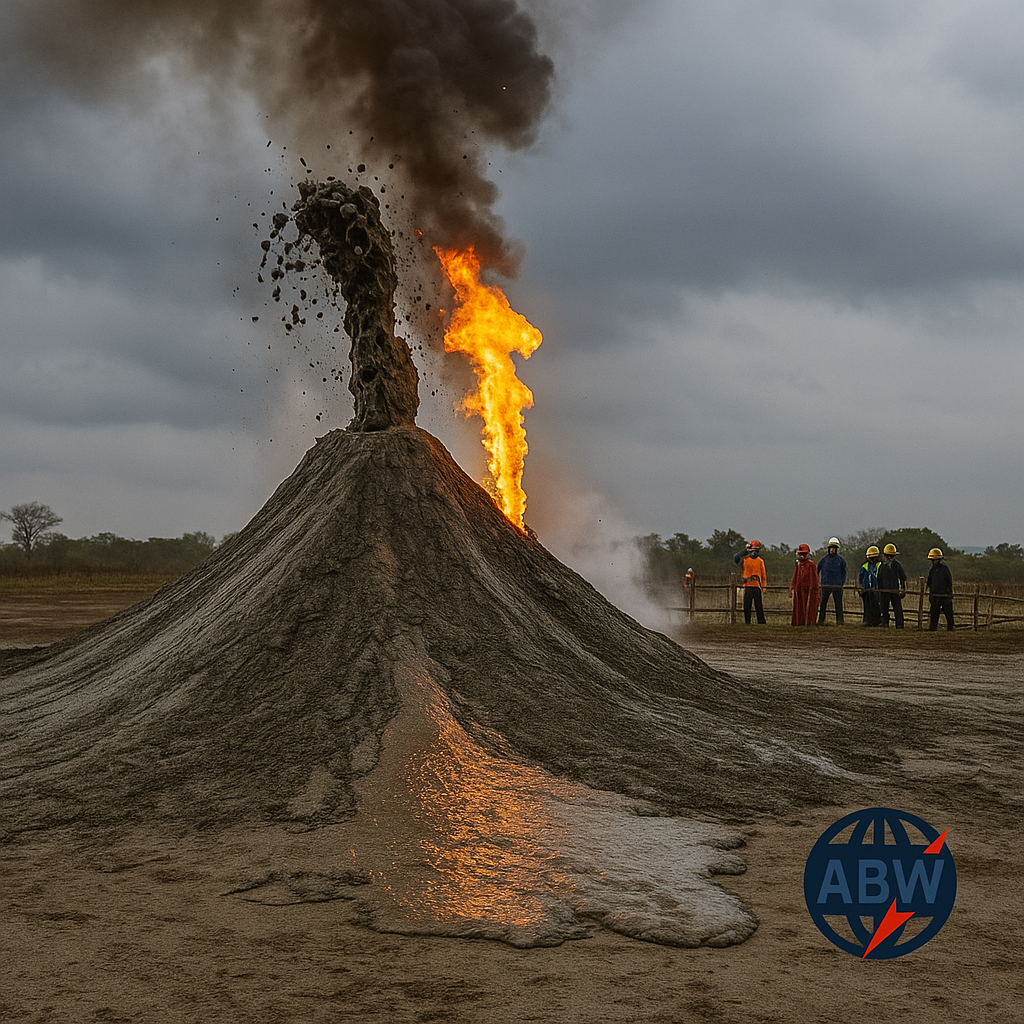Taiwan mud volcano eruption turns a quiet field into a fiery show
A Taiwan mud volcano eruption in the rural township of Wandan, southern Taiwan, has once again transformed a normally quiet landscape into a grey, bubbling cauldron crowned with flickering flames. As thick mud and gas burst from the ground, locals gathered around the crater, some throwing burning rags into the vent to ignite the methane-rich gas. The scene – equal parts science experiment and street festival – spread quickly on social media, captivating viewers who may never have heard of mud volcanoes before. Taiwan News+1
This latest activity at the Wandan mud volcano, which has erupted repeatedly in recent years, is a reminder that not all volcanoes spew lava and ash. Some exhale mud, water and gas instead – and in Taiwan’s case, they do so in one of the most tectonically active corners of Asia. Geologists say the Wandan site is a particularly unusual and active example of this phenomenon, with eruptions that can reappear in new spots kilometres away from the main vent. Taiwan News+2ResearchGate+2
For nearby communities, the mud volcano is both a curiosity and a low-level hazard. For scientists, it is a natural laboratory that offers clues about the forces shaping Taiwan’s crust, the movement of underground fluids and the way greenhouse gases like methane leak from the Earth. Understanding these things helps us put spectacular videos of flaming mud into their proper context – and to ask harder questions about safety, climate and long-term geological change.
Taiwan mud volcano eruption at Wandan: what exactly happened?
The latest Taiwan mud volcano eruption took place at the Wandan site in Pingtung County, southern Taiwan. Witnesses reported fountains of watery mud and gas erupting from vents in the ground, building up low cones of grey sediment that slowly oozed outward. According to local reports, the eruption lasted for hours, with bursts of activity punctuated by quieter intervals. Taiwan News+1
Video clips show spectators standing at the edge of the mud cone, tossing flaming rags or sticks into the crater. When these burning objects hit the rising gas, they ignited the methane, creating a ring or “crown” of flames hovering above the bubbling mud. The effect is dramatic but also potentially dangerous; methane is highly flammable, and sudden changes in gas flow or pressure can produce unexpected bursts. Geologist Mark Tingay, who has studied mud volcanoes around the world, notes that the Wandan site regularly emits significant methane and that locals sometimes deliberately burn it off during eruptions. Live Science+1
While this latest event drew global attention, it is not an isolated incident. Wandan is one of Taiwan’s most active mud volcanoes. Local monitoring suggests it has erupted at least once a year for decades and around 10–11 times in just the last three years, sometimes forming new vents hundreds of metres or even kilometres away from the main crater. Taiwan News+2LinkedIn+2 In other words, what looks like a freak event on video is actually part of a long-running pattern of activity.
What is a mud volcano – and how is it different from a “normal” volcano?
To understand the Wandan spectacle, it helps to clear up a common misconception: mud volcanoes are not true magma volcanoes. They rarely involve molten rock, lava flows or explosive ash clouds. Instead, they are driven by pressurised fluids – usually a mix of water, mud and gas – that escape from deep underground through weak spots in sedimentary basins. Wikipedia+2Encyclopedia Britannica+2
Here’s what typically happens:
- Thick layers of sediment accumulate in a basin over millions of years.
- Organic material buried in those sediments breaks down, generating hydrocarbons including methane.
- Fluids and gases become trapped and pressurised at depth, especially along faults and folds created by tectonic forces.
- When pressure becomes high enough, these fluids punch their way upward, carrying mud and rock fragments with them.
- At the surface, they erupt as mud cones, bubbling pools or low domes, sometimes forming small craters that can grow, collapse and migrate over time. Wikipedia+1
Most mud volcanoes are relatively cool compared with lava volcanoes, with temperatures often close to that of groundwater. Yet they can still be hazardous. The gas they release is dominated by methane – a flammable, asphyxiating gas that is also a powerful greenhouse gas. Globally, researchers estimate that mud volcanoes contribute a noticeable slice of the natural methane budget, potentially several percent of total geologic methane emissions to the atmosphere. Wikipedia+2Woods Hole Oceanographic Institution+2
In short, mud volcanoes sit at the intersection of geology, climate and energy. They reveal how fluids move through the crust, they shape local landscapes, and they quietly leak fossil methane that might otherwise remain locked underground.
Why southern Taiwan is a hotspot for mud volcanoes
Taiwan sits on a complex tectonic boundary where the Philippine Sea Plate and the Eurasian Plate collide. The southern part of the island, including Pingtung and nearby Kaohsiung, overlies a mud diapir system – a zone where deep, soft sediments have been squeezed and forced upward, providing ideal conditions for mud volcanoes. ResearchGate+1
Studies of mud volcanoes in southern Taiwan show that:
- Many are aligned along faults and folds created by compressional tectonics.
- Fluids rise from several kilometres below the surface, carrying fine-grained sediments and hydrocarbons.
- Some eruptions appear to be linked to nearby earthquakes, suggesting that seismic shaking can briefly open pathways and trigger sudden mud and gas release. ResearchGate+2Sciency Thoughts+2
The Wandan mud volcano fits squarely into this pattern. It lies near the boundary of Wandan and Xinyuan townships in Pingtung County, surrounded by farmland and low-lying villages. Past eruptions have occasionally opened vents in fields, roads or temple grounds, leaving mounds and craters that slowly weather away until the next pulse of activity. Authorities have treated the area as a notable geological feature and, at times, fenced off active vents to keep visitors at a safe distance. Taiwan News+1
This tectonic backdrop explains why Taiwan can host both towering mountain ranges and quirky features like mud volcanoes in such a small area. The island’s ongoing collision and uplift continue to rearrange stress and pressure underground, priming mud volcano systems for repeated eruptions.
From grey sludge to a ring of fire: methane and the Wandan flames
One of the most striking images from the recent Taiwan mud volcano eruption is the “crown” of flames hovering above the crater. The visual punch comes from methane, the dominant gas released at Wandan and at many mud volcanoes worldwide. Wikipedia+2Live Science+2
Methane has three key roles in this story:
- Fuel for fire – When methane mixes with air at the right ratio and meets a spark or flame, it ignites. At Wandan, locals accelerate this process by tossing burning rags into the vent. In other mud volcano regions such as Azerbaijan, flames can ignite naturally as gas meets sparks from colliding rocks or man-made sources and may shoot tens or even hundreds of metres into the sky. Smithsonian Magazine+2Wikipedia+2
- Clue to underground processes – The presence of methane tells geologists that organic-rich sediments deep below are generating hydrocarbons and that faults or fractures are acting as pipelines to the surface. Isotopic analyses can even hint at the depth and conditions of gas formation. Wikipedia+2ResearchGate+2
- Greenhouse gas concern – Methane is far more potent than carbon dioxide over short time scales. Natural sources such as mud volcanoes are part of Earth’s carbon cycle, but their emissions still contribute to overall atmospheric methane levels. Researchers estimate that onshore and shallow offshore mud volcanoes may release several to tens of teragrams (millions of tonnes) of methane per year. Wikipedia+2Woods Hole Oceanographic Institution+2
At Wandan, burning the gas changes methane into carbon dioxide and water vapour, which are less powerful greenhouse gases on a per-molecule basis – but the practice is not without risks. Getting close enough to throw flames into an active vent exposes people to toxic gases, sudden bursts of mud, ground collapse and burns. While the flaming crown makes for dramatic footage, geologists generally advise keeping a generous distance from active mud volcanoes, especially during eruptions. USGS+1
Taiwan mud volcano eruption patterns: a restless system
The Wandan mud volcano has earned a reputation for frequent and sometimes unpredictable behaviour. Local records and expert commentary suggest that:
- Eruptions have occurred at least once a year since the late 1980s. Taiwan News+1
- In the last few years, the site has erupted around ten or more times, sometimes from multiple vents at once. LinkedIn+1
- New vents can appear several hundred metres away from existing ones, sometimes beneath roads or next to temples, forcing authorities to reroute traffic or temporarily close public areas. Taiwan News+1
In April 2022, one notable eruption preceded a magnitude-5.7 earthquake south of Taiwan by about 90 minutes. Some scientists suggested that rising fluids in the mud volcano system and regional seismic stresses might have been linked, though proving a direct connection is challenging. Sciency Thoughts
This restless pattern makes Wandan an ideal place to study how changing pressures in sedimentary basins translate into surface phenomena. By tracking when and where vents open, geologists hope to better understand whether mud volcano eruptions can provide subtle signals of deeper tectonic processes – or whether they primarily reflect local, shallow conditions.
Global perspective: when mud volcanoes become disasters
The Wandan Taiwan mud volcano eruption is relatively small, attracting tourists more than evacuation orders. Elsewhere in the world, though, mud volcanoes have caused major disasters.
Indonesia’s Lusi mud volcano
In eastern Java, Indonesia, the Lusi mud volcano began erupting in May 2006 near a gas drilling operation. Over the following months and years, it flooded entire neighbourhoods with scalding mud. Research suggests that tens of thousands of people were displaced, dozens of villages and factories were destroyed, and the economic cost climbed into the billions of US dollars. Berkeley News+2environmentandsociety.org+2
Fiery eruptions in Azerbaijan
Azerbaijan, on the shores of the Caspian Sea, hosts the highest concentration of mud volcanoes on Earth, with more than 300 identified features. Some eruptions there have produced enormous flames as methane ignites, with fire columns reportedly reaching hundreds of metres into the air. A famous event in 2021 on Dashli Island generated a massive fireball visible from the capital Baku and prompted investigations into possible impacts on nearby oil and gas infrastructure. Smithsonian Magazine+2Wikipedia+2
These examples show that mud volcanoes, while often quieter than lava volcanoes, can still be dangerous when they intersect with dense populations or critical infrastructure. Taiwan’s mud volcanoes are smaller, but their proximity to farms, roads and towns means that authorities must monitor them carefully and manage access when activity intensifies.
Mud volcanoes, methane and the climate question
From a climate perspective, mud volcanoes matter for two main reasons:
- Natural methane emissions – Studies suggest that mud volcanoes and related seeps release significant amounts of methane each year. While estimates vary widely, some work indicates they could account for several percent of global natural methane emissions. This makes them an important piece of the puzzle when scientists try to balance the planet’s methane budget and distinguish human-caused emissions from natural ones. Wikipedia+2Woods Hole Oceanographic Institution+2
- Hydrocarbon pathways – Many mud volcanoes are associated with oil and gas fields. Gas that escapes through mud volcanoes is gas that doesn’t remain trapped underground, which can influence how companies explore and model petroleum basins. In places like Azerbaijan and parts of Southeast Asia, the presence of mud volcanoes is often a clue that large hydrocarbon reserves lie at depth. Wikipedia+2Wikipedia+2
In Taiwan’s case, the Wandan mud volcano is a relatively modest methane source compared with major industrial and agricultural emissions. Still, its eruptions offer a tangible reminder that the Earth has its own long-running, natural contributions to atmospheric greenhouse gases – and that even remote fields and small craters connect to global climate discussions.
Safety and tourism: is it safe to visit Wandan mud volcano?
The viral videos of the latest Taiwan mud volcano eruption make Wandan look like an impromptu festival site, with residents standing close to the crater rim and using open flames around methane. From a safety standpoint, that behaviour carries real risks.
Key hazards include:
- Sudden mud bursts – Eruptions can change intensity quickly, sending jets of mud several metres into the air. Getting hit by dense, hot mud at close range can cause burns or injury. USGS+1
- Ground instability – The area around an active vent may be undermined by fluid movement, creating sinkholes or collapses that are not obvious to the eye.
- Gas exposure – Methane can displace oxygen near the ground, and other gases such as hydrogen sulphide may be present in small amounts, posing inhalation risks.
- Fire and explosion – Open flames near concentrated methane can cause flash fires or explosions, especially if gas accumulates in pockets. USGS+1
For visitors, the safest way to appreciate Taiwan’s mud volcanoes is to follow local regulations: stay behind fences, obey warning signs, and avoid bringing ignition sources near active vents. Some mud volcano areas in Taiwan have been set aside as nature reserves or geological parks, with designated viewing platforms and information boards that explain the phenomenon without encouraging risky behaviour. OFF THE BEATEN TRACK+1
Responsible tourism can help local communities benefit economically from their unique geology while keeping people – and the environment – out of harm’s way.
Why scientists are fascinated by the Taiwan mud volcano eruption
Beyond the spectacle, each Taiwan mud volcano eruption at Wandan delivers valuable scientific data. Researchers and agencies can:
- Track gas composition to understand where the fluids originate and how they move through the crust. ResearchGate+1
- Monitor temperatures and pressures to see how quickly the system responds to tectonic changes or rainfall. Woods Hole Oceanographic Institution+1
- Compare eruption timing with earthquakes to explore possible links between seismicity and mud volcanism. Sciency Thoughts+1
- Use satellite and drone imagery to watch how cones grow, collapse and migrate over time.
Because Wandan erupts so frequently, it offers many opportunities to observe these processes in real time. Long-term records from Taiwan and other mud volcano regions feed into global studies of how sedimentary basins evolve, how hydrocarbons escape and how natural methane sources behave on decadal scales.
Conclusion: more than a viral clip of flaming mud
At first glance, the Wandan Taiwan mud volcano eruption looks like a simple viral spectacle: villagers tossing fire into a bubbling pit, flames dancing over grey sludge, smartphones held aloft. But beneath that surface drama lies a complex story of tectonic collision, pressurised fluids, greenhouse gases and human adaptation.
Mud volcanoes like Wandan are modest in size yet rich in meaning. They demonstrate how the Earth releases energy and fluids in subtle ways, remind us that natural methane emissions are part of the climate system, and show how local traditions grow around recurring geological events. For Taiwan, they are another chapter in a broader narrative of living on the edge of active plate boundaries – a place where mountains rise, earthquakes strike, and even the flat fields occasionally erupt.
As scientists continue to probe the Wandan system and as communities adjust to its restless behaviour, one thing is clear: the next time flames crown a mud volcano in southern Taiwan, we will see not just a fiery show but a glimpse into the deep and dynamic processes shaping our planet.
External sources for further reference
- Taiwan News – “Mud volcano erupts in southern Taiwan” Taiwan News
- Live Science – coverage and analysis of the Wandan mud volcano flames and methane ignition Live Science
- Research on mud volcanoes in southern Taiwan (Pingtung and Kaohsiung) and their mud diapir system ResearchGate+1
- Wikipedia – “Mud volcano” (background on mud volcano processes and global distribution) Wikipedia
- Encyclopaedia Britannica – “Mud volcano” explainer on formation and gas emissions Encyclopedia Britannica
- USGS – “Volcano Watch: here’s the dirty truth about mud volcanoes” (hazards and methane ignition) USGS
- Sciency Thoughts – “Eruption from the Wandan Mud Volcano, Taiwan” (earthquake link and eruption description) Sciency Thoughts
- AFP Fact Check – background on Wandan as a particularly active mud volcano in Pingtung County Fact Check AFP
- Studies on methane emissions from mud volcanoes and their role in the global methane budget Woods Hole Oceanographic Institution+1
- Reporting and research on the Lusi mud volcano disaster in Indonesia Berkeley News+2environmentandsociety.org+2
- Articles on fiery mud volcano eruptions in Azerbaijan and Dashli Island Smithsonian Magazine+2Wikipedia+2


